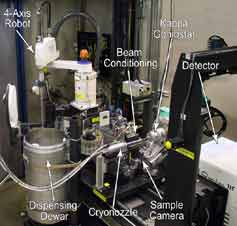
Handy Links
SLAC News Center
SLAC Today
- Subscribe
- Archives: Feb 2006-May 20, 2011
- Archives: May 23, 2011 and later
- Submit Feedback or Story Ideas
- About SLAC Today
SLAC News
Lab News
- Interactions
- Lightsources.org
- ILC NewsLine
- Int'l Science Grid This Week
- Fermilab Today
- Berkeley Lab News
- @brookhaven TODAY
- DOE Pulse
- CERN Courier
- DESY inForm
- US / LHC
SLAC Links
- Emergency
- Safety
- Policy Repository
- Site Entry Form

- Site Maps
- M & O Review
- Computing Status & Calendar
- SLAC Colloquium
- SLACspeak
- SLACspace
- SLAC Logo
- Café Menu
- Flea Market
- Web E-mail
- Marguerite Shuttle
- Discount Commuter Passes
-
Award Reporting Form
- SPIRES
- SciDoc
- Activity Groups
- Library
Stanford
Around the Bay
Standing on the Shoulders of Robots
Over the past three years, the macromolecular crystallography beamlines at SSRL have enjoyed a spike in scientific popularity, with more and more users from around the world taking advantage of the technologies available for determining the structure of molecules. And increasingly, those users are doing that work without stepping foot into a laboratory.
For many years, the growing demand for beamtime placed a premium on getting more done in less time. To figure out the structure of a protein molecule, researchers first screen numerous and often hundreds of samples of specially prepared crystals, each no bigger than a grain of salt, to find one suitable for closer x-ray study. Cycling through those hundreds of samples can take an enormous amount of time, a problem that SSRL engineers have solved by automating the process with robots.
Before robotic automation, each sample could take as long as 15 minutes to screen. Researchers had to open and enter the experimental hutch and manually place a sample in front of the x-ray beam, each time taking a series of steps to avoid the radiation hazard. Nowadays, dewars containing crystallized samples are tended by robots, which can pluck a sample from cold storage and place it in the x-ray beam in under 10 seconds.
Now, with the automated system refined and running smoothly, engineers have gone a step further, devising "remote access" software that allows researchers to operate the robots remotely over a secure Internet connection. Because protein crystallography studies involve repeated measurements of the same kind, it is a science especially well-suited for automation. And thanks to recent improvements to the experimental control software called "Blu-Ice," all six protein crystallography beamlines at SSRL are remotely accessible. A user could, in theory, collect data at SSRL with a laptop and a wireless connection from a beach chair under the sun in Australia.
"If you're not going inside the hutch anyway, and you're controlling everything with a computer, it doesn't really matter where you are," said Aina Cohen, who directs the prototype development and operations group for macromolecular crystallography at SSRL.
Although other synchrotron facilities offer varying degrees of remote accessibility, SSRL is the only lab that has fully automated and remotely accessible macromolecular crystallography beamlines. After the samples arrive at SSRL by courier and an SSRL scientist prepares the experimental hutch, users can conduct and modify the experiment in real time—adjusting variables like which samples are studied, the x-ray exposure time, and the angle of the robotic sample holder.
Today, as many as 50% of protein crystallography users at SSRL perform their experiments remotely. Most protein crystallography experiments use the same techniques over and over, and automating the process speeds up the experiment dramatically.
"This has really helped with scheduling beamtime," Cohen said. "Plus, it frees up time for specialized experiments that need extra attention."
The macromolecular crystallography group is now collaborating with groups from the ALS and APS to develop a sample storage container that will work with automated systems at all three labs.
This development was supported by NIH NCRR and DOE BER.
Image: A macromolecular protein crystallography experimental hutch with an automated robotic arm. Samples remain in cold storage in the dispensing dewar. (Click on image for larger version.)
—Brad Plummer
SLAC Today, July 5, 2006
